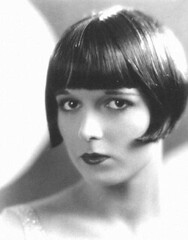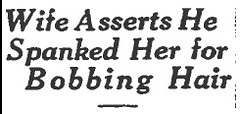Wed 24 Feb, 2010
Hair Today, Gone Tomorrow
Comments (1) Filed under: EventsTags: 1920s, Art Deco, bobbed hair, Clara Bow, Colleen Moore, Egyptian Theater, F. Scott Fitzgerald, flappers, Hollywood, Louise Brooks, silent films
I want to express my thanks to those of you who attended my lecture last Sunday in the historic Egyptian Theater in Hollywood. The lecture was co-hosted by the Los Angeles Art Deco Society, and American Cinematheque, and was followed by a screening (with LIVE musical accompaniment provided by pianist Robert Israel) of the 1927 film “It”, starring Clara Bow.
Here’s a clip from the film:
Clara sure had “It”, and her sassy bob was a major part of her appeal.

Irene Castle
What about bobbed hair? Did Clara Bow create it? And if she didn’t, who did? There is evidence which suggests that Antek Cierplikowski (aka Mssr. Antoine) may have bobbed the hair of French actress Eva Lavalliere as early as 1909 — but it was dancer Irene Castle who popularized the style in 1914 when she cut her own hair in advance of elective surgery. Irene may have clipped her locks for convenience, but thousands of women were smitten by both the style and the ease of her adorable cropped ‘do and they immediately followed her lead. Scissors were soon flying in barbershops all over the U.S.
Irene Castle gave the bob its first little nudge into popular culture, but silent film star Colleen Moore brought the bob to mainstream America in the film “Flaming Youth” in 1923. Writer and chronicler of all things flapper, F. Scott Fitzgerald, said: “I was the spark that lit up Flaming Youth, Colleen Moore was the torch. What little things we are to have caused all that trouble.”
Colleen’s hair was styled in a sweet dutch boy crop; but there was plenty of room for different interpretations of the bob from Clara Bow’s carefree tousled hair, to Louise Brooks’ sleek black helmet.

Louise Brooks
Despite their different on- and off-screen personas, all three women epitomized the flapper in general, and the glorified the bob hairdo in particular. The bob has survived to be 100 years old is because it has readily adapted to the whims of fashion.
Bobbed hair was de riguer for flappers, and of course flappers were glorified in film, literature, poetry — all of the arts. I believe that no single person did more to immortalize the flapper than writer F. Scott Fitzgerald. And he didn’t just talk the talk — he and his wife Zelda led others of the “Lost Generation” on a decade long party.
Years after the flapper had taken her last illegal drink, and attended her final petting party, Fitzgerald’s short story, “Bernice Bobs Her Hair”, was brought to television by PBS. The 1976 production starred Shelley Duval (Bernice) and Bud Cort (Warren). In this clip Bernice asks Warren for his opinion on the hair bobbing issue.
Conversations like the one Bernice and Warren were having on the dance floor, were taking place in thousands of American homes during the 1920s. The hair bobbing issue was a hot topic and caused broken engagements, divorce, and even the spanking of a wife by her husband!
From our vantage point it may be difficult to believe that something as simple as a haircut could cause so much controversary — we’re accustomed to choosing our personal style with virtually no constraints (and that may not always been a good thing.)
Nevertheless, whether you have long hair, or short, props must be given to the women of the 1920s who paved the way for all of the rest of us — we owe them a debt.


Judy says:
I was reading a fashion magazine today where they referred to the bob as “traditional.” It’s come a long way!